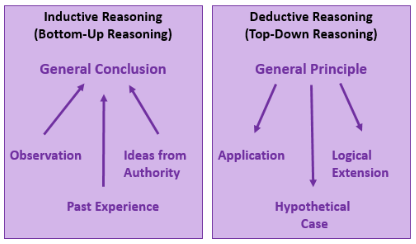6.6: Cognitive Development in Adolescence
Learning Objectives: Cognitive Development in Adolescence
|
Piaget’s Formal Operational Stage of Cognitive Development
During the formal operational stage, adolescents are able to understand abstract principles which have no physical reference. They can now contemplate such abstract constructs as beauty, love, freedom, and morality. The adolescent is no longer limited by what can be directly seen or heard. Additionally, while younger children solve problems through trial and error, adolescents demonstrate hypothetical-deductive reasoning, which is developing hypotheses based on what might logically occur. They are able to think about all the possibilities in a situation beforehand, and then test them systematically (Crain, 2005). Now they are able to engage in true scientific thinking.
Formal operational thinking also involves accepting hypothetical situations. Adolescents understand the concept of transitivity, which means that a relationship between two elements is carried over to other elements logically related to the first two, such as if A<B and B<C, then A<C (Thomas, 1979). For example, when asked: If Maria is shorter than Alicia and Alicia is shorter than Caitlyn, who is the shortest? Adolescents are able to answer the question correctly as they understand the transitivity involved.
Does everyone reach formal operations? According to Piaget, most people attain some degree of formal operational thinking, but use formal operations primarily in the areas of their strongest interest (Crain, 2005). In fact, most adults do not regularly demonstrate formal operational thought, and in small villages and tribal communities, it is barely used at all. A possible explanation is that an individual’s thinking has not been sufficiently challenged to demonstrate formal operational thought in all areas.
Adolescent Egocentrism: Once adolescents can understand abstract thoughts, they enter a world of hypothetical possibilities and demonstrate egocentrism or a heightened self-focus. The egocentricity comes from attributing unlimited power to their own thoughts (Crain, 2005). Piaget believed it was not until adolescents took on adult roles that they would be able to learn the limits to their own thoughts.

David Elkind (1967) expanded on the concept of Piaget’s adolescent egocentricity. Elkind theorized that the physiological changes that occur during adolescence result in adolescents being primarily concerned with themselves. Additionally, since adolescents fail to differentiate between what others are thinking and their own thoughts, they believe that others are just as fascinated with their behavior and appearance. This belief results in the adolescent anticipating the reactions of others, and consequently constructing an imaginary audience. “The imaginary audience is the adolescent’s belief that those around them are as concerned and focused on their appearance as they themselves are” (Schwartz, Maynard, & Uzelac, 2008, p. 441). Elkind thought that the imaginary audience contributed to the self-consciousness that occurs during early adolescence. The desire for privacy and reluctance to share personal information may be a further reaction to feeling under constant observation by others.
Another important consequence of adolescent egocentrism is the personal fable or belief that one is unique, special, and invulnerable to harm. Elkind (1967) explains that because adolescents feel so important to others (imaginary audience) they regard themselves and their feelings as being special and unique. Adolescents believe that only they have experienced strong and diverse emotions, and therefore others could never understand how they feel. This uniqueness in one’s emotional experiences reinforces the adolescent’s belief of invulnerability, especially to death. Adolescents will engage in risky behaviors, such as drinking and driving or unprotected sex, and feel they will not suffer any negative consequences. Elkind believed that adolescent egocentricity emerged in early adolescence and declined in middle adolescence, however, recent research has also identified egocentricity in late adolescence (Schwartz, et al., 2008).
Consequences of Formal Operational Thought: As adolescents are now able to think abstractly and hypothetically, they exhibit many new ways of reflecting on information (Dolgin, 2011). For example, they demonstrate greater introspection or thinking about one’s thoughts.
Information Processing
Cognitive control: As noted in earlier chapters, executive functions, such as attention, increases in working memory, and cognitive flexibility have been steadily improving since early childhood. Studies have found that executive function is very competent in adolescence. However, self-regulation, or the ability to control impulses, may still fail. A failure in self- regulation is especially true when there is high stress or high demand on mental functions (Luciano & Collins, 2012). While high stress or demand may tax even an adult’s self-regulatory abilities, neurological changes in the adolescent brain may make teens particularly prone to more risky decision making under these conditions.

Inductive and Deductive Reasoning: Inductive reasoning emerges in childhood, and is a type of reasoning that is sometimes characterized as “bottom-up-processing” in which specific observations, or specific comments from those in authority, may be used to draw general conclusions. However, in inductive reasoning the veracity of the information that created the general conclusion does not guarantee the accuracy of that conclusion. For instance, a child who has only observed thunder on summer days may conclude that it only thunders in the summer. In contrast, deductive reasoning, sometimes called “top-down-processing”, emerges in adolescence. This type of reasoning starts with some overarching principle, and based on this proposes specific conclusions. Deductive reasoning guarantees a truthful conclusion if the premises on which it is based are accurate.
Intuitive versus Analytic Thinking: Cognitive psychologists often refer to intuitive and analytic thought as the Dual-Process Model; the notion that humans have two distinct networks for processing information (Albert & Steinberg, 2011). Intuitive thought is automatic, unconscious, and fast (Kahneman, 2011), and it is more experiential and emotional. In contrast, Analytic thought is deliberate, conscious, and rational. While these systems interact, they are distinct (Kuhn, 2013). Intuitive thought is easier and more commonly used in everyday life. It is also more commonly used by children and teens than by adults (Klaczynski, 2001). The quickness of adolescent thought, along with the maturation of the limbic system, may make teens more prone to emotional intuitive thinking than adults.

